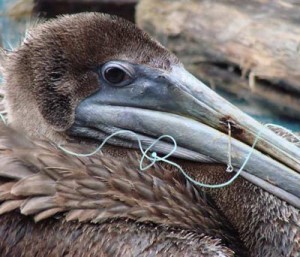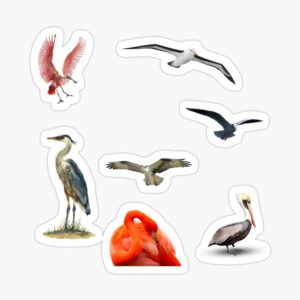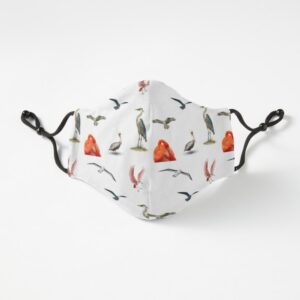It’s a beautiful day and the fishing is good. Suddenly, the line snags on something as the cast is made. A bird is hooked. Don’t panic. There’s a way to get that bird released. Reel Remove Release

“The first thing to know is don’t cut the line,” said Kevin Oxenrider, a biologist with the Florida Fish and Wildlife Conservation Commission (FWC). “Birds that fly away with hook and line attached are at risk of getting entangled in trees and dying. And that line is left to possibly snare other wildlife.”
The FWC has come out with these steps to rescue a hooked bird: Reel in the bird. Remove the hook. Release the bird. Go to www.MyFWC.com/unhook for details.
“If possible, enlist others for assistance,” Oxenrider said.
Reel the bird in slowly and evenly. Don’t try to shake the bird loose by jerking the line – it will inflict additional injury to the bird.
Make sure that the bird remains on the water until a net, such as a hoop net, can be used to lift it out of the water. Birds reeled up out of the water can be seriously injured, or can potentially damage fishing equipment.
Wear sunglasses to protect your eyes. Take extra care to protect yourself when handling long-billed wading birds and hooked-billed cormorants
“Many people are afraid to grab a large bird like a pelican, but there’s a way to do it without hurting the bird or the rescuer,” Oxenrider explained.
Firmly grasp the bird’s head behind the eyes. Then fold the wings up gently but firmly against the bird’s body so that it can’t flap its wings, and hold the legs. Hold firmly but don’t strangle the bird. If it is a pelican, hold the beak but keep it slightly open so the bird can breathe.
Rescuers can also cover the bird’s head with a towel, hat, shirt or other cloth. This will calm the bird and make it easier to remove the line and/or hook.
Remove the hook by cutting the barb and backing the hook out. If the barb is imbedded in the bird’s flesh, push the hook through until the barb emerges from the skin and then clip the barb.
If the bird is entangled in line, use scissors, clippers or a knife to gently cut the line. Place the cut line in a monofilament recycling bin, or cut the line into small (less than 3-inch) pieces and place in a lidded trashcan. Carefully check the bird for other hooks or line and remove them too.
If the bird is feisty, it is likely healthy enough to release. Place the bird’s feet on the ground and step back while you release the bird. Let the bird take off on its own. Sometimes birds shake out their feathers, assess the situation and are then ready to fly. Other times, they just take off. Either way, this represents a successful release.
If the bird has swallowed the hook, or is severely injured, take it to a local rehabilitator. For a list of rehabbers in your area, go to: MyFWC.com/education and click on “Learn about Wildlife,” then “Unhook Seabirds” and “list of rehabilitators” near the bottom of the page.
Monofilament and fishing tackle left in the environment create potential traps for unsuspecting wildlife that become entangled or snared, leading to injury and death.
What can you do to prevent bird entanglement?
- Don’t feed pelicans and other waterbirds. This causes them to congregate in areas where they are more likely to get hooked or tangled in fishing line. Feeding pelicans is prohibited by law (F.A.C. 68A-4.001).
- Discard fish carcasses in lidded trash cans. Birds will feed on carcasses tossed in the water, which can lead to injury or death. Fish carcasses often are larger than the bait fish that birds normally feed upon, and the larger bones and spines can puncture the bird’s throat or digestive tract. Birds attracted by fish carcasses may gather in areas where they are more likely to become entangled in fishing line.
- Cast away from birds and shoreline vegetation.
- Collect and store loose monofilament line until it can be discarded properly.
- Keep bait buckets covered.
- Take unused bait home.
- Let other anglers know how to prevent bird entanglement.
“By being responsible anglers and spreading the word about ‘Don’t cut the line! Reel. Remove. Release’ (at www.MyFWC.com/unhook) we can save birds and other wildlife from becoming entangled and losing their lives,” Oxenrider said.
One of Florida Keys Treasures is all the beautiful birdlife you can watch and photograph. Here are a few of my favorite birds: Rosette Spoonbill, Albatross, Seagull, Great Blue Heron, Osprey AKA Fish Hawk, Pink Flamingo, and the Brown Pelican.
This design, by KeysTreasures.RedBubble.com is available on 80+ products including Clothing, Mugs, Pillows, Stickers, Masks and much more.



Greetings!
I work as the Youth Education Director for the Golden Gate Audubon Society in California. We are making a film for our county Clean Water Program aimed at teaching youth about the impacts of plastic trash and fishing line on wildlife.
We are featuring pelicans in our film and hoped to find photos of birds affected by fishing line and we discovered your powerful photo.
May we use the above photo for our educational film?
Thanks so much for your time and great work,
Anthony
This photo originally came from this site.
https://www.bird-rescue.org/our-work/research-and-education/how-plastics-affect-birds.aspx
I’m sure they would grant you use of the photo.